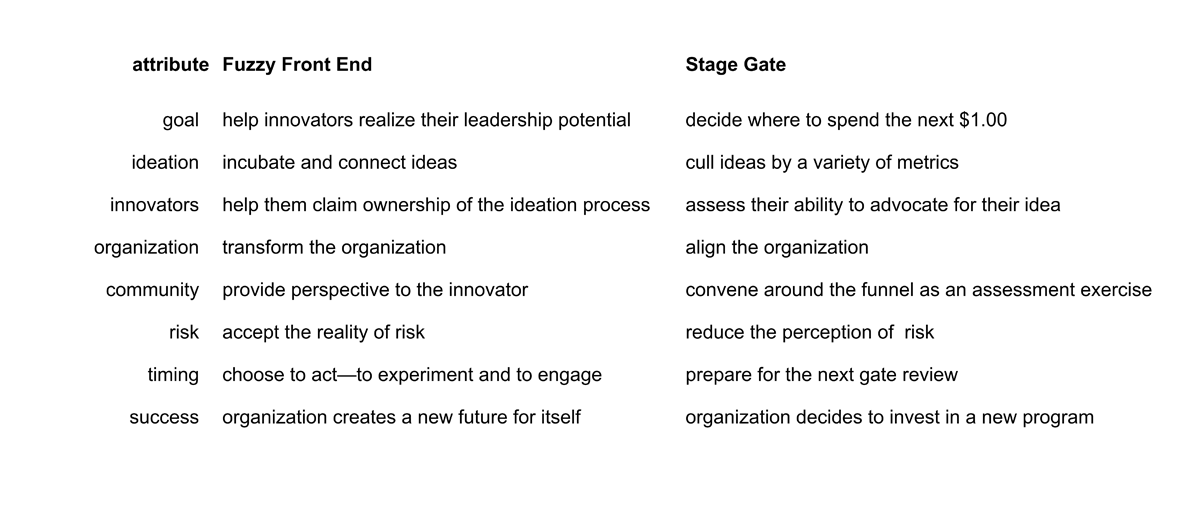By: Doug Collins
Much of the action in innovation during the past five years has been around the front end of innovation – acquiring and gating new ideas. Doug Collins asks whether we are applying the right processes to the fuzzy front end..
A number of innovation groups with whom I engage work in the civil engineering industry. They design and build structures and equipment that their clients expect to last 100 years before they will need to replace them.
As you can imagine, the culture that defines these organizations places a premium on meticulous planning and analysis. If the wise carpenter laboring in the construction industry measures twice and cuts once, the ones who work in this space measure ten times before they feel comfortable in wielding a saw.
This mindset makes perfect sense. Who wants to live below a poorly designed dam? Who wants to raise their family next to a pipeline that leaks petrol whenever the temperature falls below freezing? Who wants to invest 10 million Euros in a poorly conceived capital improvement project?
At the same time, this mindset can cause the groups—in reality, any group whose culture places a premium on process as a means of reducing perceived risk—to fail to distinguish between the related, yet distinct practices of ideation as experienced in the fuzzy front end and commercialization as practiced through a gating process. Groups that blur the lines between the two will often, for example, choose to expend time and energy on perfecting elaborate funnels or vetting processes within the fuzzy front end at the expense of thinking through how to engage with the ideation community that they will invite to explore new possibilities. The funnel serves as a visual metaphor for culling a population of concepts down to the set that the organization chooses to formally support and, often by extension, fund. Figure 1 delineates the differences between the attributes associated with the fuzzy front end and the gating process.
Figure 1: distinguishing between the fuzzy front end and the stage gate process
The larger implication of putting the cart before the horse is that the organization fails to create a shared process in which people explore the possibility of claiming ownership of and pursuing the innovation process in the ways that make sense to them, transforming the organization into a more innovative version of itself.
To this end, then, what should happen in the fuzzy front end? If we do not apply a stage gate process, then what do we do? The remainder of this article provides food for thought on this question.
First, and with deference to a long line of thinkers such as Peter Block, David Boehm, and Peter Senge who have approached this topic in powerful ways, ask yourself who you choose to invite to the innovation community. Does each person add to the diversity of the community relative to the population at large? Do they understand, through dialogue with you, why you invite them to participate? Do they accept your invitation? “No,” is a perfectly fine answer that opens the door to a deeper conversation with them on this front.
In many organizations, an invitation to engage in an activity often comes in the form of an e-mail blast announcing the start of an initiative. While this approach may work well for potluck dinners and blood drives, I could envision few worse ways to invite people to participate in an innovation community. Why? Because the practice of innovation—the act of forming, framing, and reframing an idea—begins and endures with dialogue. What are we here to create together? What does the future look like if we were to pursue the idea in question? What if we choose to pursue the idea—to try or trial it ourselves, outside the bounds of what the initiative prescribes? You missed critical steps if a prospective community member first learns of the initiative through e-mail or through the people working in the organization’s corporate communications department.
Ideas can be killed from a distance. They can only advance up close and in person.
Secondly, have you taken any steps to combine a virtual community with convening a community in person? Virtual communities serve a valid purpose. Primarily, they help organizations bridge time and space for the many instances when the community cannot convene in person. They help innovators and the ties that exist between them and their ideas persist. For better or worse, we increasingly live in a world where we work physically removed from one another. They do not, however, substitute for the authentic dialogue and ensuring transformation that occurs when the innovation community convenes.
The good news for groups who have committed to helping their organizations become more innovative is that a lot of very smart people, through years of trial and error, have developed powerful ways in which to engage communities, regardless of the nature of their shared interest. Mere mortals will find the approaches very accessible. My advice to anyone who has committed to serving in this role is to start with The World Café by Brown and Isaacs. You will come to find that the more transformative aspects of your innovation campaign become possible—sometimes seemingly miraculously possible—when you follow their guidance in convening the community in a way that respects the collective intelligence of the group. Here again, this approach is night-and-day different from what we so often experience in gate reviews where we twist people’s arms to meet so that they can probe for deficiencies in a revolving door of unwitting presenters.
Thirdly, what plans have you developed to coach the innovators—the idea creators—and the teams that form around the ideas that resonate with their colleagues? What experience can you offer them in terms of connecting with others in the organization who have successfully pursued their ideas to fruition? What opportunities can you offer the team to experiment with and trial their idea before running the commercialization gauntlet? Can you, for example, broker dialogue between innovator and consumer?
What’s that? You say you were not planning to dig in that far? Why not? Why would you choose not to commit to practicing the same form of leadership that you would expect the innovators to purse?
In closing, the fuzzy front end does not conform to the shape of a funnel. To the contrary, one idea may produce the seed that germinates ten more. Turn the funnel upside down. The funnel becomes a pyramid. By extension, your role becomes helping the community form powerful questions, coaching the people who express leadership in responding to them (i.e., answering the call of “What if?”), and convening the community in person so that they can benefit from the collective intelligence they literally bring to the table, as people who participate in World Cafes come to understand. Running people through gauntlets and otherwise attempting to hold the unwilling accountable has no place in this world. Figure 2 delineates some of the attributes that comprise the virtual and physical complements of the fuzzy front end. Each makes a related, yet distinct contribution to the success of your activity. Considering the possibilities of weaving the two together represents time well spent.
Figure 2: paying attention to what matters on the fuzzy front end—weaving together the virtual and physical communities
Yes, a stage gate process has its place for the practical reasons we can imagine. We have all suffered on the receiving end of half-baked plans delivered by people reading verses from different pages of the book. Yet, I can think of few more effective ways to smother the fuzzy front end of the larger innovation process than to attempt to apply the culling and assessing practices that the stage gate emphasizes. Do not, for example, fall into the trap of literally counting the number of ideas percolating in the fuzzy front end, as if the Accounts Receivables department had mysteriously annexed the activity.
Process has its place. So, too, does exploration reified through reflection and dialogue. With respect to my friends in civil engineering, it’s the difference between designing a bridge and envisioning the possibilities of a world without bridges.
By Doug Collins
About the Author:
 Doug Collins serves as an innovation architect. He has served in a variety of roles in helping organizations navigate the fuzzy front end of innovation by creating forums, venues, and approaches where the group can convene to explore the critical question. He today works at Spigit, Inc., where he consults with Fortune 1000 clients on realizing their vision for achieving leadership in innovation by applying social media and ideation markets in blended virtual and in-person communities.
Doug Collins serves as an innovation architect. He has served in a variety of roles in helping organizations navigate the fuzzy front end of innovation by creating forums, venues, and approaches where the group can convene to explore the critical question. He today works at Spigit, Inc., where he consults with Fortune 1000 clients on realizing their vision for achieving leadership in innovation by applying social media and ideation markets in blended virtual and in-person communities.
Previously, Doug formed and led a variety of front end initiatives, including executive advisory programs for industry influencers, early adopter programs for lead users, corporate strategic planning, and structured explorations of new market and product opportunities. Before joining Spigit, Doug worked at Harris Corporation and at Structural Dynamics Research Corporation which is now part of Siemens Corporation.


